ALBUQUERQUE, N.M. — One of the nation’s premier nuclear laboratories isn’t taking the necessary precautions to guard against wildfires, according to an audit by the U.S. Energy Department’s inspector general.
The report comes as wildfire risks intensify across the drought-stricken U.S. West. Climatologists and environmentalists have been warning about worsening conditions across the region, particularly in New Mexico, which is home to Los Alamos National Laboratory and where summer rains failed to materialize last year and winter precipitation has been spotty at best.
The birthplace of the atomic bomb, Los Alamos has experienced hundreds of millions of dollars in losses and damage from major wildfires over the last two decades. That includes a blaze in 2000 that forced the lab to close for about two weeks, ruined scientific projects, destroyed a portion of the town and threatened tens of thousands of barrels of radioactive waste stored on lab property.
Watchdog groups say the federal government needs to take note of the latest findings and conduct a comprehensive review before the lab ramps up production of key plutonium parts used in the nation’s nuclear arsenal.
“The threat and risks of wildfire to the lab and northern New Mexico will continue to increase because of climate warming, drought and expanded nuclear weapons production,” said Jay Coghlan, director of the group Nuclear Watch New Mexico.
The audit released this month found that cutting back vegetation along power lines and other measures to reduce the risk of catastrophic fires were not always done, increasing the potential for another devastating fire like the Cerro Grande Fire in 2000.
Federal auditors said not all fire roads were maintained to ensure safe passage for firefighters and equipment responding to blazes on lab property.
The audit also cited federal policy that requires a comprehensive, risk-based approach to wildfire management — something the inspector general's office said had not been developed by the contractor that manages the lab for the U.S. government. It also pointed to a lack of oversight by Energy Department field staff.
“Without documenting planning and preparedness activities, there was no assurance that all prevention and mitigation options were considered and that the site was fully prepared for wildland fire events," the audit says.
The report included photos that depicted overgrown areas. In Los Alamos Canyon, for example, specialists indicated there were about 400 to 500 trees per acre. Auditors said the ideal number should be 40 to 50 trees per acre.
Lab spokesman Peter Alden Hyde said that since the audit was conducted in late 2018 and early 2019, the lab has adopted “an aggressive approach” to wildfire management on its 39-square-mile (
“We continue to review our wildfire and forest health plans and have already implemented most of the recommendations the Department of Energy offered to improve our efforts to protect the public, the environment and the laboratory,” he said.
It was not immediately clear how many acres were thinned during the last year or whether the lab had any major projects planned for 2021.
Susan Montoya Bryan, The Associated Press



